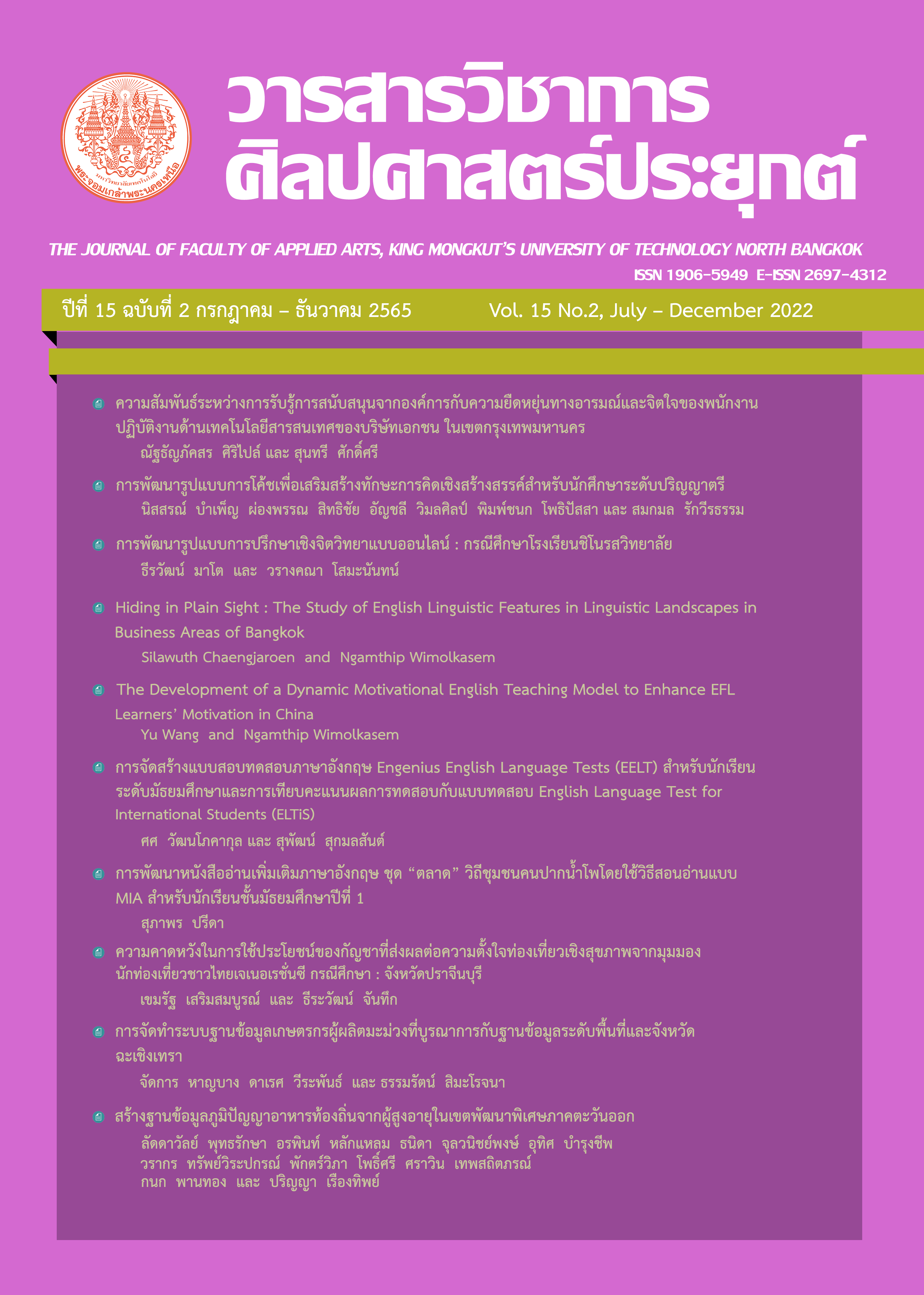การพัฒนารูปแบบการสอนภาษาอังกฤษเชิงพลวัตแรงจูงใจเพื่อสร้างแรงจูงใจของผู้เรียนภาษาอังกฤษเป็นภาษาต่างประเทศในประเทศจีน
Main Article Content
บทคัดย่อ
งานวิจัยนี้เป็นการบูรณาการทฤษฎีแรงจูงใจในการเรียนภาษาที่สองและการสอนภาษาที่สองในการพัฒนารูปแบบการสอนภาษาอังกฤษเชิงพลวัตแรงจูงใจเพื่อสร้างแรงจูงใจของผู้เรียนภาษาอังกฤษเป็นภาษาต่างประเทศในประเทศจีน วัตถุประสงค์ของการศึกษานี้เพื่อพัฒนารูปแบบการสอนนี้และตรวจสอบผลของรูปแบบการสอนนี้ต่อแรงจูงใจของผู้เรียน งานวิจัยนี้เป็นงานวิจัยเชิงประจักษ์โดยแบ่งกลุ่มนักศึกษาชั้นปีที่ 1 จำนวน 84 คนเป็น 2 กลุ่ม คือ กลุ่มทดลองและกลุ่มควบคุม โดยกลุ่มทดลองเรียนด้วยรูปแบบการสอนภาษาอังกฤษเชิงพลวัตแรงจูงใจส่วนกลุ่มควบคุมเรียนด้วยวิธีการสอนแบบเดิม หลังจากการเรียน 1 ภาคการศึกษา มีการเปรียบเทียบระดับแรงจูงใจของนักศึกษาทั้งสองกลุ่มโดยใช้แบบสอบถามเพื่อสำรวจแรงจูงใจเก็บข้อมูลทั้งก่อนและหลังการเรียนรวมทั้งแบบรายงานตนเอง ข้อมูลเชิงปริมาณวิเคราะห์ด้วยค่ามัชฌิม ส่วนเบี่ยงเบนมาตรฐาน และการทดสอบ t-test แบบอิสระ ส่วนข้อมูลเชิงคุณภาพวิเคราะห์ด้วยวิธีการวิเคราะห์เนื้อหาเพื่อหาสาระสำคัญที่เกี่ยวข้องจากแบบรายงานตนเองของนักศึกษา ผลการวิจัยแสดงให้เห็นว่านักศึกษาในกลุ่มทดลองมีระดับแรงจูงใจสูงกว่ากลุ่มควบคุมอย่างมีนัยสำคัญ ซึ่งแสดงให้เห็นว่ารูปแบบการสอนภาษาอังกฤษเชิงพลวัตแรงจูงใจช่วยพัฒนาระดับแรงจูงใจในการเรียนภาษาอังกฤษของนักศึกษาในบริบทของการศึกษาระดับมหาวิทยาลัยของประเทศจีนให้เพิ่มขึ้น
Article Details

อนุญาตภายใต้เงื่อนไข Creative Commons Attribution-NonCommercial-NoDerivatives 4.0 International License.
1.บทความที่ตีพิมพ์เป็นลิขสิทธิ์ของวารสารวิชาการศิลปศาสตร์ประยุกต์ การนำเนื้อหา ข้อความหรือข้อคิดเห็น รูปภาพ ตาราง ของบทความไปจัดพิมพ์เผยแพร่ในรูปแบบ ต่าง ๆ เพื่อใช้ประโยชน์ในเชิงพาณิชย์ ต้องได้รับอนุญาตจากกองบรรณาธิการวารสารอย่างเป็นลายลักษณ์อักษร
2.ข้อความที่ปรากฏในบทความแต่ละเรื่อง เป็นความคิดเห็นส่วนตัวของผู้เขียนแต่ละท่านไม่เกี่ยวข้องกับวารสารวิชาการศิลปศาสตร์ประยุกต์ และบุคลากร คณาจารย์ท่านอื่น ๆ ในวารสารฯ แต่อย่างใด ความรับผิดชอบองค์ประกอบทั้งหมดของบทความแต่ละเรื่องเป็นของผู้เขียนแต่ละท่าน หากมีความผิดพลาดใด ๆ ผู้เขียนแต่ละท่านจะรับผิดชอบบทความของตนเองแต่ผู้เดียว
เอกสารอ้างอิง
Ajzen, I. (1991). The theory of planned behavior [J]. Organizational Behavior and Human Decision Processes, 50, 179-211.
Bi, Zheng. (2017). POA teaching material use research : Evaluation of output goals [J], Chinese Foreign Language Education, (2), 40-46.
Cai, J. G. (2010). Some thoughts on re-orientation of college English teaching in China. Foreign language teaching and research, 4, 306-308.
Clément, R., Dörnyei, Z. & Noels, K. A. (1994). Motivation, self‐confidence, and group cohesion in the foreign language classroom. Language Learning, 44(3), 417-448.
Creswell, J. (2011). Educational research: planning, conducting, and evaluating quantitative and qualitative Research. Boston : Pearson.
Csizér, K. & Kormos, J. (2009). Learning experiences, selves and motivated learning behavior : A comparative analysis of structural models for Hungarian secondary and university learners of English. In Z. Dörnyei & E. Ushioda (Eds.). Motivation, language identity and the L2 self (pp. 98-119). Clevedon, UK : Multilingual Matters.
Cumming, Alister. (2017). Design and directions for research. Chinese Journal of Applied Linguistics, 4, 459-463.
Dörnyei, Z., Z. Ibrahim & C. Muir. (2015). “Directed motivational currents”: Regulating complex dynamic systems through motivational surges [A]. In Z. Dörnyei, P. D. MacIntyre & A. Henry (eds.). Motivational Dynamics in Language Learning [C] (pp. 95-106). Bristol : Multilingual Matters.
Dörnyei, Z., A. Henry & C. Muir. (2016). Motivational Currents in Language Learning: Frameworks for Focused Interventions [M]. New York : Routledge.
Dörnyei, Z. & Malderez, A. (1997). Group dynamics and foreign language teaching. System, 25(1), 65-81.
Dörnyei, Z. (2001). Motivational strategies in the language classroom. Cambridge : Cambridge University Press.
______. (2005). The psychology of the language learner : Individual differences in second language acquisition. Mahwah, New Jersey : Lawrence Erlbaum.
______. (2009). The L2 motivational self-system. In Z. Dörnyei & E. Ushioda (Eds.), Motivation, language identity and the L2 self (pp. 9-42). Clevedon, UK : Multilingual Matters.
Dörnyei, Z. & Kubanyiova, M. (2014). Motivating learners, motivating teachers. Cambridge : Cambridge University Press.
Dörnyei, Z. & Ushioda, E. (2011). Teaching and researching motivation (2nd ed.). Harlow, UK : Pearson Education.
Duan, Yilei. (2020). A study of L2 motivational intervention in blended teaching settings [J]. Foreign Language Education in China, 20, 222-228.
Egbert, J. (2003). A study of flow theory in the foreign language classroom. Modern Language Journal, 87(4), 499-518
Guilloteaux, M. J. & Z. Dörnyei. (2008). Motivating language learners: a classroom-oriented investigation of the effects of motivational strategies on student motivation. TESOL Quarterly, 42, 55–7.
Kang, Leiming. (2016). English Teaching Design of College Athletes from Multimodal Semiotic. Journal of Wuhan Institute of Physical Education, 24, 168-196.
Kaplan, A., Garner, J. K. & Brock, B. (2019). Identity and Motivation in a Changing World : A Complex Dynamic Systems Perspective: Theory, Research, and Implications for Practice. Advances in Motivation and Achievement, 20, 101-127.
Li, Baomin & Gong, Lingling. (2019). Research on the Influence of Cooperative Learning on Students' Learning Achievements : Based on Meta-analysis of 54 Experimental Studies or Quasi-experimental Studies at Home and Abroad [J]. Research on Education Development, 4, 123-145.
Li, Jieli. (2007). Empirical research on the feasibility of cooperative learning in university English large class teaching [J]. Journal of Xi’an International Studies University, 12, 23-40.
Liang, T. (2002). Implementing Cooperative Learning in EFL Teaching : Process and Effects (Doctoral dissertation, National Taiwan Normal University). Retrieved from http://www.asian-efl-journal.com/Thesis_Liang_Tsailing.pdf
Matsuda, Paul. (2017). Some thoughts on the production-oriented approach. Chinese Journal of Applied Linguistics, 4, 468-469.
Muir, C. & Dörnyei, Z. (2013). Directed motivational currents : Using vision to create effective motivational pathways [J]. Studies in Second Language Learning and Teaching, 3, 357-375.
Polio, Charlene. (2017). Reflections on the production-oriented approach via pre-service teachers. Chinese Journal of Applied Linguistics, 4, 464-467.
Slavin, R. (1995). Cooperative learning: Theory research and practice. Boston MA : Allyn and Bacon.
Taguchi, T., Magid, M. & Papi, M. (2009). The L2 motivational self-system among Japanese, Chinese and Iranian learners of English : A comparative study. In Z. Dörnyei & E. Ushioda (Eds.), Motivation, language identity and the L2 self (pp. 66-97). Clevedon, UK : Multilingual Matters.
Thompson, S. A. & Erdil-Moody, Z. (2014). Operationalizing multilingualism : Language learning motivation in Turkey. International Journal of Bilingual Education and Bilingualism, 19(3), 314-331.
Wang, Xin, Dai, Weidong. (2015). Empirical Study of Two-Language motivational Strategy Based on the "Two-Language motivational Self-System" Theory [J]. Foreign Language Teaching, 6, 48-52.
Wang, Juan. (2021). An exploration on an interactive teaching practice of College English listening courses based on Superstar Learning Platform [J]. English Square, 6, 45-67.
Wen, Qiufang. (2017). The Chinese characteristics of POA. Modern Foreign Language, 3, A348-358.
Wen, Q. F. (2015). The production-oriented approach to teaching adult English learners. Language Teaching, 51(4), 526-540.
Williams, M. & Burden, R. L. (1997). Psychology for Language Teachers : A Social Constructivist Approach. Cambridge : Cambridge University Press.
Zhang, Jie. (2011). A study of hybrid audio-lingual model in college English teaching with the support of mobile technology (Doctoral dissertation). Northeast Normal University, China.
Zhang, Lingli. (2017). An experimental study on the effectiveness of the production-oriented approach. Modern Foreign Language, 40, 369-376.
Zheng, Hanwen. (2004). Cooperative learning in English teaching. Zhanjiang Normal University Journal, 25, 112-1154.


